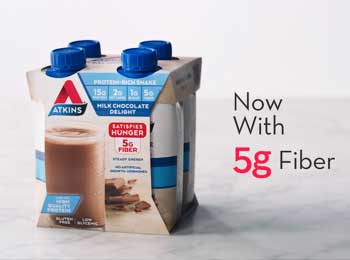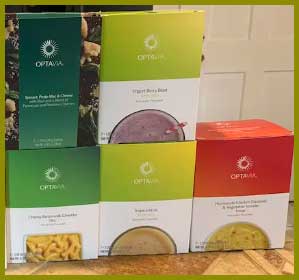When it comes to popular low-carb diets for weight loss, Atkins and Optavia are two of the biggest names. Both emphasize limiting carbs to kickstart fat-burning ketosis. But there are some key differences between these two plans.
In this detailed comparison, we’ll examine the pros, cons, similarities and differences between Atkins and Optavia. Learn how the diets work, what you can eat, and which may be better for your needs and preferences.
A Brief Comparison Table
| Feature | Atkins | Optavia |
| Foods Allowed | Meat, eggs, dairy, nuts, veggies, limited fruit | Optavia fuelings (bars, shakes), weekly Lean & Green meal |
| Phases | 4 phases over months with gradual carb reintroduction | 3 shorter phases focused on calorie restriction |
| Calories | No calorie counting, eat until satisfied | Very low, usually 800-1000 calories daily |
| Cost | No required specialty foods, affordable | $300+ monthly for Optavia fuelings |
| Support | Online community and optional coaching | 1-on-1 coaching included |
| Weight Loss | 1-2 lbs per week typically | 2-5 lbs per week, very rapid initially |
| Sustainability | Emphasizes lifestyle change, less relapse | Difficult to sustain long-term, higher relapse risk |
| Flexibility | More food freedom and choices | Strict fueling requirements, limited options |
Overview of Atkins and Optavia

First, let’s start with a quick rundown of the basics of each diet:
Atkins
- Created by Dr. Robert Atkins in 1972
- Focuses on limiting carbs to 20-100g per day depending on phase
- Encourages high protein from meat, eggs, dairy
- 4 phase program with gradual carb reintroduction
- Packaged bars and shakes optional
Optavia
- Part of Medifast’s line of products
- Very low carb, around 50-800 calories per day
- Eat 5 Optavia fuelings + 1 lean and green meal
- Coaching and community support included
- Meal replacement focused
Also Read: Comparison Between Premier Protein And Atkins Shakes
Key Differences Between Atkins And Optavia
Now let’s explore how these two low-carb diets compare across a number of factors:
1. Allowed Foods
Both Atkins and Optavia severely restrict carb-heavy foods like grains, starchy veggies, fruit, beans and sugar. Beyond that, their allowed foods differ:
Atkins
- Meat, poultry, fish
- Eggs, cheese, butter
- Non-starchy vegetables
- Nuts, seeds in moderation
- Limited berries in later phases
- Diet soda, coffee, tea
Optavia
- 5 Optavia fuelings per day (shakes, bars, soups)
- Weekly “Lean and Green” meal with 6-8oz protein + veggies
- Some plans allow 1 fueling swap for a zero carb Isopure protein drink
As you can see, Atkins provides more food options and flexibility. Optavia relies heavily on packaged meal replacements.
2. Phases of the Diets
Atkins and Optavia both utilize phased approaches to gradually decrease and then reintroduce carbs. But Atkins’ phases are longer.
Atkins
Phase 1: Under 20g net carbs per day
Phase 2: Slowly add back nuts, low carb vegetables
Phase 3: Incrementally add fruits, starchy foods
Phase 4: Incorporate carbs to find personal balance
Optavia
Phase 1: Eat only Optavia fuelings (30-50g carbs daily)
Phase 2: Add weekly Lean and Green meal (50-100g carbs)
Phase 3: Transition to low-carb, portion-controlled diet
So Atkins eases you into a sustainable low-carb eating pattern over a series of months. Optavia’s phases are shorter and focused on an intense calorie deficit using their products.
3. Calories and Macros
Speaking of calories, that’s another major difference between these plans:
Atkins
- No strict calorie counting
- Focus on carb and protein intake
- Encourages eating until satisfied
Optavia
- Very low calorie, usually 800-1000 per day
- Macros not specified
- Rely on Optavia fuelings to create large deficit
Atkins leaves calories and fat/protein ratios open-ended at first. The emphasis is solely on carb restriction.
With Optavia, you’ll likely consume under 50g of carbs and 800-1000 calories per day. This forces your body to burn fat quickly, but may not be sustainable long-term.
4. Cost Comparison

One advantage of Atkins is that you can eat regular grocery store foods, keeping costs low. Optavia’s pre-made fuelings get expensive:
Atkins
- No required specialty foods
- Can purchase some Atkins snacks optionally
- Overall low grocery costs
Optavia
- Must buy Optavia fuelings at ~$5 each
- Additional costs for fresh produce for Lean & Green meals
- Estimated $300+ monthly, not including coaching
Optavia’s simplicity comes at a price. Depending on your budget, the monthly expense may be prohibitive. Atkins provides more flexibility to eat affordably.
5. Support Resources
Support can make a big difference when trying to stick to any diet. Here’s how Atkins and Optavia compare:
Atkins
- Website with recipes, meal plans, articles
- Large member community for accountability
- Optional coaching for a fee
Optavia
- One on one coaching included
- Support groups and online community
- Health coaches provide accountability
Optavia’s personal coaching sets it apart from many diets. Having daily check-ins can help with motivation and addressing challenges. Atkins leaves more of the process up to you.
6. Effectiveness for Weight Loss
Of course, the big question is – how much weight can you lose on each diet?
Both plans are effective for rapid weight loss in the short term. However, Optavia’s very low calorie approach may have the upper hand.
Atkins
- Many lose 5-10 lbs in the first two weeks
- 1-2 lbs per week loss after initial water weight drop
Optavia
- Expect to lose 10+ lbs in the first month
- Up to 2-5 lbs of fat burned per week
- Quick results from calorie deficit
The downside is that aggressive calorie restriction can cause rebound weight gain when normal eating resumes after Optavia. Atkins’ slower pace leads to more sustainable loss for many.
Watch this review video:
7. Ease of Following
In terms of which diet is easier to stick to:
Atkins
- No calorie tracking required
- More food freedom with protein, veggies, fats
- Can eat out more easily
Optavia
- Very simple: 5 fuelings + 1 meal per day
- No meal prep or planning involved
- Portion sizes and choices limited
If you want simplicity, Optavia delivers. But the restricted food options and high costs make it harder for some people to follow long term. Atkins offers more flexibility and affordability.
8. Health Effects
Both diets can help improve health markers related to excess weight:
Potential Benefits
- Lower blood sugar and insulin levels
- Reduced cholesterol and blood pressure
- Less inflammation
- Better fertility, PCOS symptoms
However, very low calorie diets like Optavia require medical monitoring to ensure nutritional needs are met. Atkins has a better track record for being generally safe long-term.
Sustainability
The biggest knock on very restrictive diets is that weight regain happens when normal eating is resumed. So which is more sustainable?
Atkins
- Carbs are added back gradually in phases
- Flexibility to find carb threshold for maintenance
- Emphasizes making long-term lifestyle changes
Optavia
- Very difficult to sustain calorie levels indefinitely
- Must transition carefully back to regular foods
- Higher likelihood of bouncing back after
Atkins focuses more on developing low-carb eating habits for the long haul. Optavia helps kickstart rapid weight loss, but the ultra-low calorie approach has high relapse potential.
Also Read: Comparison Between ProLon And OPTAVIA
Frequently Asked Questions (FAQs)
There are a few key reasons Optavia tends to produce rapid weight loss results: Very low calorie intake – Usually under 1000 calories daily, Heavily restricted carbs – Around 50g or less per day, Pre-portioned fuelings – Makes calorie deficit effortless, Personal coaching – Provides accountability and support.
By strictly limiting calories and carbs through Optavia fuelings, most people lose weight quickly in the first 1-2 months. However, such an extreme approach is difficult to maintain.
The Atkins diet slowly increases net carbs through different phases: Phase 1: Under 20g carbs daily
Phase 2: Slowly add nuts, low carb vegetables, Phase 3: Incrementally add small servings of fruit, beans, whole grains, Phase 4: Find your personal carb tolerance for maintenance. So Atkins can range from under 20g in the initial induction phase, up to around 100-120g carbs once you identify your ideal daily carb intake.
Optavia is very effective for short-term weight loss, but it may not be the best for sustainable long-term results due to its restrictive approach.
Some programs that may work better in the long run include: WW (Weight Watchers) – Flexible eating plan with support resources, Noom – Uses psychology-based coaching for lifestyle changes, Mayo Clinic Diet – Solid medical advice and reasonable approach, Volumetrics – Focuses on eating low density foods to feel full. Finding a healthy eating pattern you can stick with forever is the best option for maintaining weight loss over years.
The main things to avoid on Atkins are:
Sugar including sweets, soda, juice, Grains including bread, pasta, rice, Starchy vegetables like potatoes, corn, peas, Most fruits, especially tropical fruits and dried fruit, Legumes including beans and lentils, Low fat dairy products, Beer and sweetened alcoholic drinks. Focus instead on quality proteins, healthy fats, non-starchy veggies, nuts and seeds, cheese, eggs, herbs and spices for flavor. Limit high carb foods to keep your body in fat burning mode.
Also Read: Comparison Between Diet Direct And Optavia.
Final Thought
There’s no definitively “better” option here – it depends on your needs and preferences:
Atkins may be better if:
- You want flexibility and food options
- Prefer gradual over rapid weight loss
- Seeking an affordable long-term diet
- Want minimal calorie tracking
Optavia may be better if:
- You need structured simplicity
- Seeking faster short-term results
- Want personal coaching/accountability
- Don’t mind relying on packaged meals
Take your health history, motivations, and lifestyle into account. This can help determine if Atkins or Optavia is the better match.

